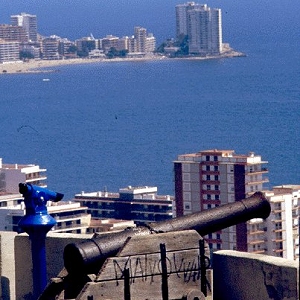
Like us on Facebook
PLACE NAMES


 
|
|
València
|

| | |
Valencia is the capital of the autonomous community of Valencia and the third largest city in Spain after Madrid and Barcelona, with around 0.8 million inhabitants in the administrative centre. Valencia is also Spain's third largest metropolitan area, with a population ranging from 1.7 to 2.5 million. The city has global city status. The Port of Valencia is the 5th busiest container port in Europe and the largest on the Mediterranean Sea, with a trade volume of 4.21 million TEU's.
Valencia was founded as a Roman colony in 138 BC. The city is situated on the banks of the Turia, on the east coast of the Iberian Peninsula, fronting the Gulf of Valencia on the Mediterranean Sea. Its historic centre is one of the largest in Spain, with approximately 169 acres; this heritage of ancient monuments, views and cultural attractions makes Valencia one of the country's most popular tourist destinations. Major monuments include Valencia Cathedral, the Torres de Serranos, the Torres de Quart, the Llotja de la Seda (declared a World Heritage Site by UNESCO in 1996), and the Ciutat de les Arts i les Ciències (City of Arts and Sciences), an entertainment-based cultural and architectural complex designed by Santiago Calatrava and Félix Candela. The Museu de Belles Arts de València houses a large collection of paintings from the 14th to the 18th centuries, including works by Velázquez, El Greco, and Goya, as well as an important series of engravings by Piranesi. The Institut Valencià d'Art Modern (Valencian Institute of Modern Art) houses both permanent collections and temporary exhibitions of contemporary art and photography.
Valencia is integrated into an industrial area on the Costa del Azahar (Orange Blossom Coast) but for tourism purposes, it is more associated with adjacent and better known Costa Blanca. Valencia's main festival is the Falles. The traditional Spanish dish, paella, originated in Valencia.
The original Latin name of the city was Valentia, meaning "strength", or "valour", the city being named according to the Roman practice of recognizing the valour of former Roman soldiers after a war. The Roman historian Livy explains that the founding of Valentia in the 2nd century BC was due to the settling of the Roman soldiers who fought against an Iberian rebel, Viriato.
During the rule of the Muslim kingdoms in Spain, it was called Medina at-Turab ('City of Sands'), since it was located on the banks of the River Turia—and the term Balansiyya was reserved for the entire region of Valencia.
By gradual sound changes, Valentia has become Valencia in the Castilian and València in Valencian.
 Feel free to Email me any additions or corrections Feel free to Email me any additions or corrections
LINKS AVAILABLE TO YOUR SITE
| | |





